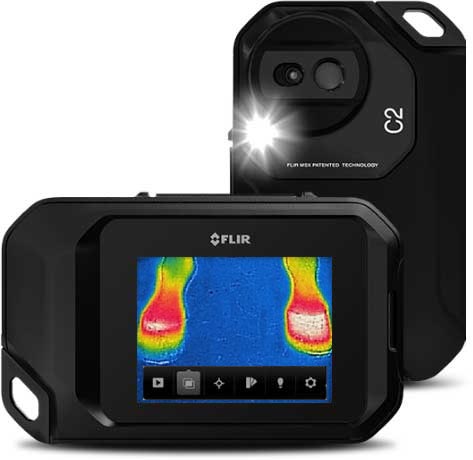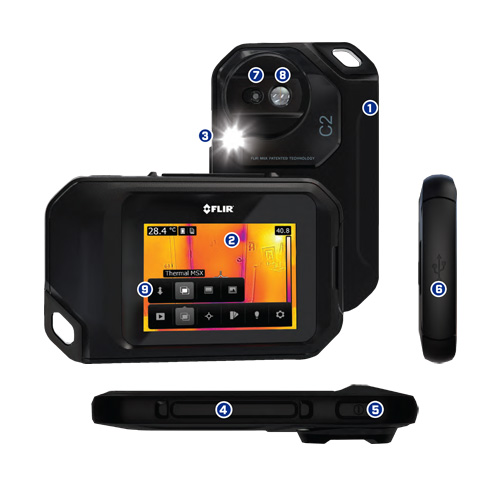

Low Cost FLIR C2 Thermal Camera
Thermal Cameras For Equine
With the power of thermal cameras, hidden injuries and health problems with horses can be easily identified and treated, long before they become a serious issue. Problems with joints, cuts and scrapes and even saddle and bridle issues can all be detected by using thermal technology, making these cameras an excellent investment for vets and those who care for horses.
Equine Thermography
Using Thermal Cameras to Study Horses
Due to the size and physiology of horses, studying them for hidden injuries, cuts, bumps, bruises and other underlying issues can be difficult.
Thermal cameras make the job significantly easier. By using thermal cameras, you can effectively study how heat circulates around the horses' body, with problematic cold and extremely hot spots likely showing an underlying issue.
They're also extremely effective tools as they require no invasive searching of the horse. Instead, simply observe the suspected problem area from a distance with the camera, capture an image and study to see if there are any problems.
issues with the horse are detected, further treatment can be diagnosed as needed.
See The Heat
With a thermal camera in your hands, heat can't hide. These tools are made to detect infrared radiation given off by objects, then interpret that radiation and display it on an image as different colours.
Advanced Analysis
Ideal for simple spot checks or in-depth medical analysis, thermal cameras can be used to detect problems long before they begin to have long-term effects on a horse's condition.
Proven Medical Benefits
With constant innovations and regular improvements to what thermal cameras can do, their use in medical applications has increased significantly over the years.
For studying animals, thermal cameras are almost invaluable tools. Several vets use thermal cameras alongside X-rays, CT, MRI and ultrasound scanning techniques to enhance their services and help to diagnose problems with animals much more effectively.
What Can They Detect?
Vets use thermal cameras to study the heat of an animal, making it easier to pinpoint potential pain areas. For horses, these problems can be vast, ranging from muscular damage to nerve injury, saddle sores, arthritis and more. Thermal cameras give professionals the means to detect these issues before they develop further, allowing a bespoke treatment plan to be created for every horse that's studied.
Non-Invasive Analysis
With a thermal camera, you won't have to worry about causing stress and worry to your horse. The cameras can be used easily from a distance, are quiet-running and don't require any physical contact. There's no sedatives, no stress and no risk involved.
Detecting Ligament and Tendon Injuries
With equine thermography, you can detect ligament and tendon damage in a horse, even before actual physical damage signs occur.
With your horse regularly going through a lot of exercise, the chances of an issue developing within the legs increases significantly. If left unchecked, such damage could be extremely deabilatating to the horse, leading to lameness and pain.
With a thermal camera, you can study the legs of a horse to detect irregular heat patterns. This is usually an early sign that tissue within the leg is under a lot of stress, leading to possible ligament/tendon damage either currently or in the near future.
By using one of these cameras, further examination of the detected problem area can be performed and vets can diagnose issues and treatment plants for animals before they become severely affected.
Hidden Problems - Found
It's in the nature of the horse to not show an injury. Due to their natural state of being a 'prey' animal, horses tend to mask their injuries, which in turn can lead to undiagnosed medical issues. If something feels not right with your horse, if its temperment changes, or its favouring a certain leg, you can use a thermal camera to look for signs of damage to the horses' legs.
Back Problems, Pain and Saddle Issue Detection
There are many signs that your horse may be suffering from pain in the spine. A badly fitted saddle, too much weight and other factors can cause pain and discomfort to horses, particularly if issues are left to develop over a period of time.
Symptoms of back pain in horses include dipping, flinching and nipping when touched/groomed, crooked riding or even anger with bucking and/or rearing. If there's an issue with the horse's back, you can use equine thermography to detect inflammations, saddle sores caused by friction or other irregularities.
Many issues with a horse's back are also caused by the horse gradually adjusting its posture due to other injuries which may have otherwise went undetected. Using a thermal camera, you can study a horse's entire body to detect potential issues, then take corrective action as soon as possible and/or conduct further analysis.
FLIR C2 at a Glance
Fully Radiometric Image
The FLIR C2 assigns every pixel in the image its own temperature reading allowing you to detect medical conditions accurately.
Live Video Streaming
Plug your FLIR C2 into a computer/TV and see temperature changes on a bigger screen.
Intuitive and Easy-To-Use
No special training required, just intuitive touchscreen and easy-to-understand buttons.
Key Features
Take a closer look:
1) Light, Slim, Pocket-Sized Design - the C2 is designed to be comfortable to hold in the hands and fits comfortably in a pocket when not in use
2) Bright, 3" Touchscreen - gives you quick and easy access to all functions
3) Built-in LED Worklight with Flash - use as a means of seeing where you're going, or for illuminating your photos
4) Large-Size Snapshot Button - easily capture thermal, visible and MSX images
5) Easy to Access ON/OFF Button - with fast power on
6) USB Micro-B Connector - use the included USB cable for file and data transfer
7) Visible Light Camera - capture a digital reference image alongside a thermal image and blend the two image types together with FLIR MSX
8) Thermal Camera - powerful FLIR thermal technology captures fully radiometric thermal images
9) Intuitive User Interface - change modes and camera settings as needed


